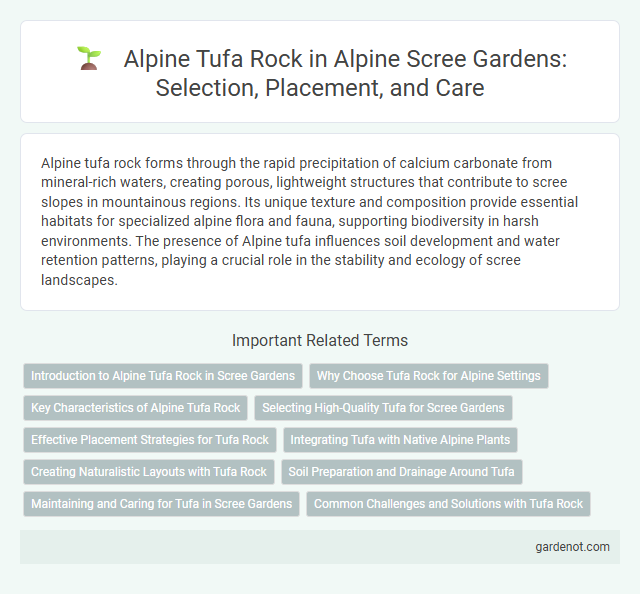Alpine tufa rock forms through the rapid precipitation of calcium carbonate from mineral-rich waters, creating porous, lightweight structures that contribute to scree slopes in mountainous regions. Its unique texture and composition provide essential habitats for specialized alpine flora and fauna, supporting biodiversity in harsh environments. The presence of Alpine tufa influences soil development and water retention patterns, playing a crucial role in the stability and ecology of scree landscapes.
Introduction to Alpine Tufa Rock in Scree Gardens
Alpine tufa rock is a porous, calcium-rich limestone formed through the precipitation of carbonate minerals in cold, spring-fed environments. Its lightweight and highly porous structure make it ideal for scree gardens, where it supports drought-tolerant alpine plants and promotes excellent drainage. The rock's natural texture and mineral composition enhance soil aeration and provide essential nutrients, fostering a sustainable alpine ecosystem in garden landscapes.
Why Choose Tufa Rock for Alpine Settings
Tufa rock offers exceptional porosity and lightweight properties ideal for Alpine scree environments, promoting efficient drainage and reducing soil erosion. Its natural mineral composition fosters moss and lichen growth, enhancing biodiversity and stabilizing steep slopes. Choosing tufa rock supports ecosystem resilience and aesthetic integration in harsh Alpine terrains.
Key Characteristics of Alpine Tufa Rock
Alpine tufa rock is characterized by its porous texture, formed through the rapid precipitation of calcium carbonate in alpine spring environments. This sedimentary rock exhibits high permeability and lightweight properties, often supporting specialized mosses and algae that contribute to its development. Its unique microhabitats play a crucial role in alpine biodiversity and hydrological processes.
Selecting High-Quality Tufa for Scree Gardens
Selecting high-quality Alpine tufa for scree gardens requires evaluating its porosity, durability, and mineral composition to ensure optimal drainage and plant support. The best Alpine tufa exhibits a lightweight, porous structure rich in calcium carbonate, promoting root aeration and moisture retention in rocky garden conditions. Avoid tufa with excessive weathering or dense, non-porous characteristics, as these reduce water regulation essential for alpine scree planting success.
Effective Placement Strategies for Tufa Rock
Effective placement strategies for Alpine tufa rock involve positioning the porous limestone in areas with adequate moisture and natural water flow to enhance mineral deposition and promote ecological stabilization. Placing tufa rock in microhabitats such as stream banks or shaded alpine scree slopes helps maximize carbonate precipitation and supports the growth of native mosses and algae. Strategic orientation to capture seasonal meltwater and minimize exposure to direct sunlight ensures optimal tufa formation and long-term landscape integration.
Integrating Tufa with Native Alpine Plants
Alpine tufa rock, characterized by its porous texture and high calcium carbonate content, provides an ideal substrate for native Alpine plants such as Saxifraga and Sedum species. Its ability to retain moisture and support mineral exchange promotes root anchorage and nutrient uptake, essential for plant survival in harsh mountainous environments. Integrating tufa with native vegetation enhances ecological stability and fosters biodiversity by creating microhabitats suited to Alpine flora.
Creating Naturalistic Layouts with Tufa Rock
Alpine tufa rock, a porous and lightweight limestone, is ideal for creating naturalistic layouts in alpine scree gardens due to its ability to retain moisture and support native plant growth. Its irregular surface texture and varied coloration enhance the visual appeal and mimic natural mountainous terrains. Incorporating tufa rock strategically improves soil aeration and provides essential microhabitats for alpine flora, promoting biodiversity and ecological stability.
Soil Preparation and Drainage Around Tufa
Alpine tufa rock requires well-drained soil with high porosity to prevent waterlogging and promote root health in scree environments. Soil preparation should include coarse sand or gravel to enhance aeration and ensure rapid drainage, mimicking natural mountain conditions. Properly managing water flow around tufa helps maintain structural integrity, reducing erosion and supporting plant colonization on the scree slopes.
Maintaining and Caring for Tufa in Scree Gardens
Maintaining Alpine tufa rock in scree gardens involves regular removal of debris and careful watering to preserve its porous structure and natural mineral composition. Protecting tufa from excessive moisture and frost damage ensures longevity, while using gentle cleaning methods prevents erosion of its delicate surface. Incorporating native Alpine plants around the tufa enhances soil stability and replicates the natural scree habitat, promoting ecological balance.
Common Challenges and Solutions with Tufa Rock
Alpine tufa rock commonly faces challenges such as porosity-induced fragility and susceptibility to weathering from freeze-thaw cycles prevalent in alpine scree environments. Effective solutions involve applying breathable sealants to enhance durability while allowing moisture exchange, alongside regular monitoring to address microcracks early. Conservation techniques also prioritize using compatible repair mortars that maintain the rock's natural permeability and structural integrity.
Alpine tufa rock Infographic

 gardenot.com
gardenot.com